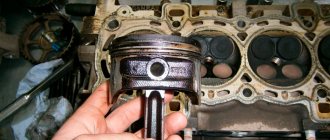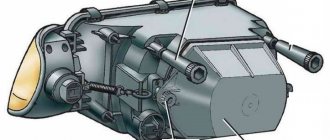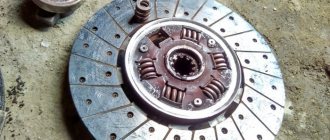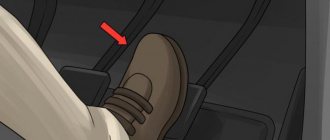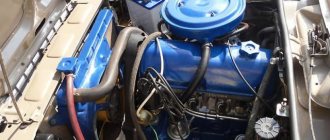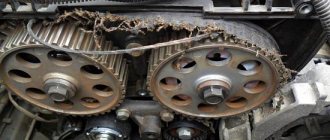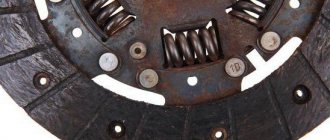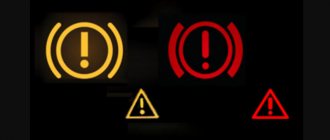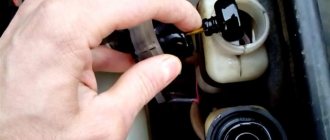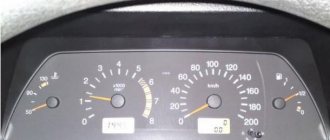The clutch is one of the main components of a car transmission, responsible for transmitting torque from the engine to the wheels. Its main function is to disconnect and reconnect gears when one of the gears is engaged. Without it, driving a car becomes impossible. And if in automatic transmissions the clutch works autonomously, then in manual transmissions it is controlled by the driver and if the clutch is used incorrectly, increased wear may be observed.
Clutch operation in different drive systems
Every driver knows that there are several types of transmission. At the moment, three are most often used in production:
- Mechanics. When you press the clutch pedal, the force is transmitted using a cable. It is in this system that it is easiest to burn a part. The cable is placed inside the casing. The housing is located in front of the pedal.
- Hydraulics. Structurally, this system consists of two cylinders. They are connected to each other by a tube that can withstand high pressure. When the driver presses the pedal, a rod with a piston at the end is activated. It creates pressure on the brake fluid, and it is transmitted to the working cylinder.
- Electrical system. In this case, the clutch has an electric motor. It is activated when you press the pedal. A cable is attached to it. The further process occurs by analogy with mechanics.
These are the three clutch systems that automobile manufacturers use in their cars. Knowing which one is installed on your car will help you avoid burning out the clutch.
Peregazovka
By switching in this way, like a “sports start”, there is a direct reduction in clutch resources. Before you start at a traffic light, remember the price tags for new parts and mechanic services at car repair shops.
As you can see, despite all its simplicity and reliability, the clutch is a very insidious and unpredictable mechanism. It often fails suddenly and confuses even experienced drivers. Compliance with simple rules guarantees a long service life.
Why is the clutch burning?
The first and most common reason why the clutch burns is increased load on the car. What is meant by this concept? First of all, this is an aggressive driving style. Due to frequent and sudden starts from a standstill, the clutch disc spins and burns out. When driving in higher gears, the torque is not as significant, and therefore the risk of disc burning is minimized. As statistics show, it is during sharp starts from first gear that the clutch burns.
But it is not only an aggressive manner that can lead to such problems. For example, let's take the GAZelle car. It would seem that this truck is unlikely to be used for aggressive driving. But there is another problem: overload. It is because of overload that the load on the clutch and other components increases. The driver, in an attempt to move off, applies gas, or increases engine speed. Accordingly, the torque also increases. This moment is too large, and therefore the disk begins to partially scroll when it comes into contact with the flywheel.
The situation is similar with cars that tow a trailer. If the latter is significantly loaded, there is a high risk of burning the clutch. Of course, during rare trips it is impossible to completely wear out the disk, but its service life will definitely decrease.
Another situation that can lead to slipping (and, accordingly, burning) of the disk is towing another car. According to traffic regulations, the weight of the first vehicle must be higher or at least not less than the one being towed. Otherwise, the clutch suffers increased wear and sometimes burns badly. Similar cases occur during winter operation. A striking example is when a car got stuck in the snow. While trying to get going, the driver burns the clutch, unaware of the consequences.
Symptoms
The first and most common is the characteristic smell. It is by the smell of burning that you can determine that the driven disk is spinning and rubbing against the flywheel with incredible force. This suggests that the friction force has significantly increased the temperature of the friction linings. In case of significant loads, the smell can persist for a long time. Moreover, the fumes waft straight into the cabin. You don't have to go outside for this. Even an inexperienced driver can identify a burnt-out clutch.
It is worth noting that in rare cases the element may slip without a characteristic odor. The signs of a burnt clutch are different here - the car simply loses its dynamics. Everything is very simple: the flywheel transmits torque, which is not fully transmitted to the driven disk. And all because its wear is critical, and it simply cannot engage with the flywheel. In the same way, you can recognize that the clutch on a motorcycle has burned out.
Clutch wear
Anytime you press the clutch pedal. But it can be normal, or it can be elevated. For example, you start off in the usual way, engine speed is up to 2000. Clutch wear will occur in any case and this is completely normal, working wear. If you start using only the clutch, then it is killed much less, because the biggest enemy of the clutch is high engine speeds and when the clutch is in half-clutch. When you just lift the pedal, the car starts to move, the clutch engages, the disc slips, and at this moment, the higher the engine speed, the more you fire the clutch. This is the worst thing for this design - high revs and the clutch pedal not being fully released. If the pedal is pressed to the floor, the clutch does not engage at all, because the discs are disconnected. At this moment, the release bearing and basket plates wear out, which become concave. It’s another matter when you start at about 4-5 thousand engine speeds. Here the wear is simply colossal. The only thing that could be worse is starting to move downhill this way, which is typical for a novice’s driving style.
Some drivers have the bad habit of keeping their foot on the clutch while driving, pressing the pedal slightly. In this case, we have loose pressure on the clutch disc, but there is always friction.
Beginners may make mistakes when starting to move. By slightly releasing the clutch pedal, they begin to drive faster than they would like, and press the brake pedal. What is happening at this moment? The car receives two commands at the same time - stop and drive. The discs touch each other a little, and the polymer disc slips. How to do it right? When pressing the brake pedal, press the clutch to the floor.
Difficulty switching on speeds
When the pedal is pressed to the floor, the driver engages the gear with difficulty (or with a characteristic crack). This indicates that the clutch was not completely disengaged.
Oiling
By the way, slippage can also occur due to oiling of the friction linings of the disc. For some reason, oil from the box gets onto the working surface of the clutch.
As a result, the disc slides in an attempt to catch on the flywheel. This malfunction is also accompanied by a burning smell. But it will look like burnt oil. If this is the case, it is necessary to diagnose the box and find out the reason why lubricant from the crankcase gets onto the disc.
Other signs
If the wear of the friction linings is already critical, the car will behave differently. Below we will look at the following signs of a burnt clutch:
- Difficult start. The car may stand still even if you release the clutch pedal. The disc does not have enough pressure to transmit torque to the box further. In this case, we can state critical wear of the driven disk.
- Jerking when moving. In this case, you can still start driving the car, but the start will create discomfort. The car starts to shake violently. As the speed increases, these jerks disappear. But they can resume again if the driver attempts to start moving from first gear. The car will also accelerate uncharacteristically when upshifting. Since the disk is not pressed tightly against the flywheel, the torque will be transmitted jerkily. The car loses acceleration dynamics. During disassembly, play in the diaphragm springs can be detected. They serve to compensate and smooth out the loads that go from the flywheel to the box. In the event of play in the damper springs on the driven clutch disc, such a mechanism is replaced with a new one entirely.
- Clutch pedal travel. If the disk burns out, the driver will notice increased pedal free play.
About automatic transmission
There is no clutch as such in an automatic transmission. Here this role is assigned to the torque converter. It includes two turbines through which oil circulates under pressure. Because of this, the clutch on an automatic transmission is often called wet. That is, torque is transmitted through oil. But can the clutch burn out on an automatic? The signs of a malfunction in this case are different. So, the box will go into emergency mode, and the gears will kick into gear. All this indicates wear of the friction packs.
But jerking can also occur for other reasons (for example, due to solenoids or a clogged valve body). Therefore, in any case, the automatic transmission needs to be diagnosed in detail.
How to get moving correctly
So, your engine is started and running in neutral. You depress the clutch pedal and engage first gear. Now you need to smoothly connect the crankshaft to the gearbox. This means that you need to press the driven disk against the flywheel rotating at a speed of 20-25 revolutions per second. To prevent the car from “jumping” and the engine suddenly stalling, we will perform this operation in three stages.
- Stage 1. Release the clutch pedal slightly. The pressure plate springs will bring the driven disk into light contact with the flywheel - your car will move and slowly begin to crawl.
- Stage 2. Hold the pedal in this position for two to three seconds. The rotation speeds of the flywheel and disk are gradually equalized - your car accelerates.
- Stage 3. The car drives confidently on the road - the torque is 100% transmitted to the gearbox. Release the pedal and remove your foot from it. A further half-engaged state of the clutch will burn the discs .
The nuances of starting from a place
To avoid burning out the clutch and crashing into the nearest tree, before starting to drive, be sure to check whether the car is on the handbrake. Before you start driving, it doesn't hurt to warm up the engine a little.
When you press the pedal all the way down and engage first gear, be sure to turn on the turn signal if necessary. Otherwise, you risk causing an accident.
To avoid burning the system, bring the pedal exactly to the moment of setting. At the same time, you can increase the pressure on the gas. The number of revolutions on the tachometer will jump to one and a half thousand revolutions.
Important!
When starting, constantly monitor the position of the tachometer needle. Unfortunately, many drivers try to monitor engine performance by relying solely on their ears. But this is not the best option, since the accuracy of such monitoring is not very high.
At first, it will be very difficult for you to correctly calculate the force with which you need to press the gas pedal. Therefore, for a while, give up shoes with hard soles. You will also have to forget about heels.
At the traffic light
According to numerous testimonies of novice drivers, some driving instructors teach to wait for a green traffic light with the clutch depressed and first gear engaged. It would seem that the discs do not touch, there is no threat of the linings burning.
In a traffic jam
Perhaps the greatest threat to traction comes from driving in traffic jams. Some drivers do not take their foot off the clutch pedal for a long time, turning it on and off, leaving the engine in first gear.
The driven disk almost constantly rubs against the flywheel disk, and asynchronously. As a result, additional heating occurs, which contributes to more intense abrasion.
Try to move in traffic jams, covering short distances in stages, turning off the gear in between and releasing the clutch.
Stopping on a slope
When driving downhill, the driver is recommended to use only the foot brake, and in extreme cases, the hand brake. It is better to move at first speed, but you should forget about the clutch pedal at this moment.
This error is typical for novice drivers who are very nervous when driving a vehicle. Using the clutch to stop on a slope will cause the engine to stall, putting you at risk of a serious accident.
Shifts with over-throttle
Every driver in his practice encounters unforeseen situations, which are often provoked by natural phenomena. Everyone has at least once had the experience of getting out of deep mud or a snowdrift when you need to boost the engine, give it high speeds and suddenly engage the clutch.
Such harsh actions will not only burn the clutch, but also damage other parts of the car.
If possible, you should avoid such situations, and if absolutely necessary, ask other road users to tow the car.
In foreign films such as "The Fast and the Furious" or "Taxi", cars constantly take off, leaving behind clouds of smoke. What is shown on the screen is absolutely not applicable in everyday life, since it “kills” the clutch. In order not to spend money on constant repairs, it is better to avoid mistakes during the operation of the car.
Proper use of the pedal
It will be useful for a beginner to learn how experienced motorists use a car clutch correctly and how the clutch works in a car. By applying simple recommendations in everyday driving, he will achieve mastery much faster if he learns to change gears correctly and engage the desired speed, reducing the load on the tires and brake discs. This applies to such driving moments as short stops (for example, at a traffic light) and turns.
How to squeeze
In essence, the correct use of a friction clutch involves the precise execution of two interrelated operations - the pedal must be pressed and then released. Simple tips will tell you how to properly squeeze the clutch:
The pedal is pressed all the way and without delay. Since the main thing is experience, it is better not to waste time on training, finding a suitable platform for this and hiring an experienced driver for the company. At first, shoes are important - to make the sensations more pronounced, they should have thin soles and no heels.
How to let go
By releasing pressure on the pedal, the driver begins to connect the engine flywheel and the driven disk to transmit rotation to the gearbox. This must be done very carefully so that the ride is as comfortable as possible:
- The pedal should not be depressed for a long time.
- It should be gradually released without sudden thrusts, pausing slightly when it is pressed in halfway.
- You must start driving the car in first gear. You can only drive off the second one in winter, when the asphalt is very slippery.
Clutch burnt out: how to get to the service center?
In the case of an automatic machine, you can only get to the service station using a tow truck. Electronics may simply not allow you to continue driving. Therefore, let's consider the situation on a manual transmission. So, if the clutch burns out, how to get there? Remembering the school physics course, it’s easy to guess that to start without slipping the disk we need a minimum torque. Naturally, the first speed gear ratios will not allow us to do this. By turning on first gear, the car will stand still. Therefore, you need to start from second, and sometimes even third gear.
Thus, the friction force will be as low as possible, and the car will be able to start moving without the disc slipping. If necessary, you can switch to a higher gear. To do this, just develop the required speed and turn on the speed. But in order to switch back to a lower one, you cannot do without re-gasping. To do this, switch the lever to the neutral position and raise the speed above three thousand. Next we turn on the lower gear.
What to replace?
Many motorists are wondering what to change. A burnt clutch cannot be restored or repaired. Therefore, a completely new driven disk is installed on the car. In addition, experts recommend inspecting the condition of the pressure plate. If the petals are bent, this element must also be replaced. In addition, the release bearing needs to be replaced. Its resource is slightly higher than that of the disk. But if you take the box apart, then install a new bearing. Otherwise, you will have to disassemble the transmission again, after 10-20 thousand kilometers. And this procedure is quite labor-intensive and painstaking.
So, we have found out the signs of a burnt clutch and the causes of this phenomenon.
Source
Why is it not recommended to hold the clutch pedal for a long time?
In this case, the disc itself does not burn, but the release bearing and the basket on which the plates are constantly concave wear out. Many people are interested in the question, how long does it take? 20-30 seconds is already a long time. Many people squeeze the clutch only to change the gearbox. But if you're at an intersection and need to merge with traffic, of course you'll be standing ready in first gear and with the clutch depressed. You can burn it down in one day, you just need to “try hard”, for example, by slipping in a pile of snow and at the same time keeping the clutch in half-clutch. During normal, measured driving this is extremely unlikely.
Contrary to popular horror stories about the clutch, we can say that it is not so easy to burn it. In any case, the resource is exhausted and, in the end, it will have to be replaced. By the way, the repair is quite expensive, because you need to remove the box, take out the release bearing, remove the basket from the flywheel, and then put everything back in place. Due to the large volume of work, the price is determined. Therefore, it is reasonable to change not only the clutch disc, but also the basket with the release bearing.
A little about the node
First, let's pay attention to the clutch itself. In short, this node can be of several types:
Most modern cars are equipped with a classic single-disc mechanism. It consists of the following elements:
- Driven disk.
- Pressure disk.
- Flywheel.
- Diaphragm spring.
- Fork and clutch release.
- Release bearing.
All these elements are placed in the gearbox housing, which is bolted to the engine. Motorists often call this place the “bell” of the checkpoint for its characteristic shape. Well, let's look at the signs of a burnt clutch.
How to extend clutch life
Always try to move off smoothly without jerking, stop jumping at traffic lights, and also eradicate the habit of keeping your foot on the clutch pedal while driving. It is also not recommended to use the car as a tow vehicle to pull someone out of snowdrifts or similar situations and not to transport heavy cargo on a trailer.
In addition, as operation progresses, it is necessary to check and adjust the clutch. This is due to the fact that the pedal stroke increases over time, and the mechanisms do not completely turn off. That is, when you press the pedal, the shafts do not turn off completely, which significantly increases the load on the gear teeth.
Clutch adjustment. Measure the distance from the mat to the pedal; if it is more than 160 mm, then you need to adjust the clutch drive. Bring the pedal travel to 120-130 mm.
To adjust, the distance from the floor to the pedal pad is measured (on most brands of cars this is 16 cm) and if the distance is outside the norm, then the pedal is adjusted.
